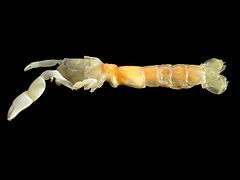Pestarella tyrrhena
| Pestarella tyrrhena | |
|---|---|
 | |
| Scientific classification | |
| Kingdom: | Animalia |
| Phylum: | Arthropoda |
| Subphylum: | Crustacea |
| Class: | Malacostraca |
| Order: | Decapoda |
| Family: | Callianassidae |
| Genus: | Pestarella |
| Species: | P. tyrrhena |
| Binomial name | |
| Pestarella tyrrhena (Petagna, 1792) | |
| Synonyms [1] | |
| |
Pestarella tyrrhena (formerly Callianassa tyrrhena) is a species of thalassinidean crustacean (ghost shrimp or mud shrimp) which grows to a length of 70 mm (2.8 in). It lives in burrows in shallow sandy parts of the sea-bed in the Mediterranean Sea and northern Atlantic Ocean. It is the most common thalassinidean in the Mediterranean,[2] and has been used as bait by fishermen for at least 200 years.[3]
Description
P. tyrrhena is a small crustacean, up to 70 millimetres (2.8 in) long,[3] with a soft exoskeleton apart from two large, unequal claws. It is whitish or greenish-grey, with pink or blue spots.[4] Because of its burrowing lifestyle, P. tyrrhena has small eyes on short stalks, and its maxillipeds can form an operculum; the telson is very short, and the rostrum is almost entirely absent.[4]
Larval development is rapid and involves few stages. Eggs hatch into a zoeal stage, which is followed by a second zoea and then a megalopa stage before adulthood. This rapid development allows the larvae to settle down into their adult habitat of relatively undisturbed muddy substrates,[2] before they have travelled too far as planktonic larvae. Larval development is retarded by low salinities and aided by warmer temperatures, giving P. tyrrhena a shorter reproductive season in the north of its range than in the south.[5]
Distribution and ecology
P. tyrrhena was first described from the Tyrrhenian Sea,[3] and is found throughout the Mediterranean as well as in the Atlantic Ocean from Mauritania and the Canary Islands north to Ireland, in the Kattegat, and in the North Sea as far as southern Norway.[1] Related species occur in the Black Sea,[3] and P. tyrrhena avoids water of low salinity, such as estuaries and the Baltic Sea.[3]
The burrows of P. tyrrhena may be up to 62 centimetres (24 in) deep. They comprise a spiral central shaft up to 20 mm wide, with one or more shallow U–shaped shafts (up to 11 mm or 0.43 in wide) which lead to the surface of the sediment where they emerge as holes or funnel–shaped depressions. These shafts may be linked by further sections, and a number of side–chambers are found filled with seagrass. The overall volume of the burrow may reach 300 millilitres (11 imp fl oz; 10 US fl oz).[6] New tunnels are continually opened and old ones filled in.[7] P. tyrrhena feeds directly on the sediment,[7] and receives nutrition from the debris collected in the debris chambers, as well as from the foraminiferans and algae which live on the walls of the burrow.[8] The activity of P. tyrrhena leads the walls of the burrow to be enriched with three times the ambient number of nematodes and more than 100 times the number of foraminiferans in the surrounding sediments.[9]
P. tyrrhena is parasitised by the isopod Ione thoracica and the barnacle Parthenopea subterranea.[10]
References
| External identifiers for Callianassa tyrrhena | |
|---|---|
| Encyclopedia of Life | 3064796 |
| ITIS | 552842 |
| NCBI | 576678 |
| WoRMS | 238027 |
| Also found in: Wikispecies | |
- 1 2 Cédric d'Udekem d'Acoz (2003). "Pestarella tyrrhena (Petagna, 1792)". Crustikon – crustacean photographic website. Tromsø Museum – University of Tromsø. Archived from the original on January 29, 2008.
- 1 2 Nguyen Ngoc-Ho (2003). "European and Mediterranean Thalassinidea (Crustacea, Decapoda)" (PDF). Zoosystema. 25 (3): 439–555.
- 1 2 3 4 5 Lipke Holthuis (1991). "Callianassa tyrrhena". FAO Species Catalogue Vol. 13: Marine Lobsters of the World. Food and Agriculture Organization. pp. 292 pp. ISBN 92-5-103027-8.
- 1 2 M. J. de Kluijver & S. S. Ingalsuo (1999). "Callianassa tyrrhena". Macrobenthos of the North Sea: Crustacea. Universiteit van Amsterdam.
- ↑ Maria Thessalou-Legaki (1990). "Advanced larval development of Callianassa tyrrhena (Decapoda: Thalassinidea) and the effect of environmental factors". Journal of Crustacean Biology. 10 (4): 659–666. doi:10.2307/1548410. JSTOR 1548410.
- ↑ Peter C. Dworschak (2001). "The burrows of Callianassa tyrrhena (Petagna 1792) (Decapoda: Thalassinidea)". Marine Ecology. 22 (1–2): 155–166. doi:10.1046/j.1439-0485.2001.00748.x.
- 1 2 Peter C. Dworschak. "Biology of Mediterranean and Caribbean Thalassinidea (Decapoda)". In A. Tamaki. Proceedings of the Symposium on "Ecology of large bioturbators in tidal flats and shallow sublittoral sediments – from individual behavior to their role as ecosystem engineers". November 1–2, 2003, Nagasaki (PDF). Nagasaki University. pp. 15–22.
- ↑ D. Abed-Navandi, H. Koller & P. C. Dworschak (2005). "Nutritional ecology of thalassinidean shrimps constructing burrows with debris chambers: The distribution and use of macronutrients and micronutrients". Marine Biology Research. 1 (3): 202–215. doi:10.1080/17451000510019123.
- ↑ H. Koller, P. C. Dworschak & D. Abed-Navandi (2006). "Burrows of Pestarella tyrrhena (Decapoda: Thalassinidea): hot spots for Nematoda, Foraminifera and bacterial densities". Journal of the Marine Biological Association of the United Kingdom. 86 (05): 1113–1122. doi:10.1017/S0025315406014093.
- ↑ Peter C. Dworschak (1998). "Observations on the biology of the burrowing mud shrimps Callianassa tyrrhena and C. candida (Decapoda: Thalassinidea)". Journal of Natural History. 32 (10–11): 1535–1548. doi:10.1080/00222939800771071.